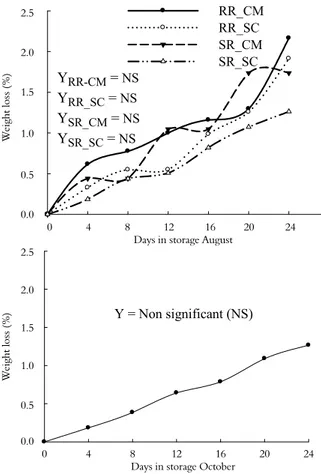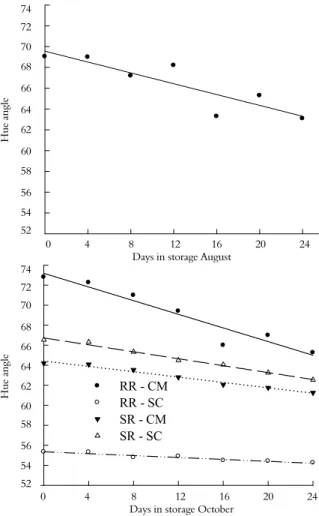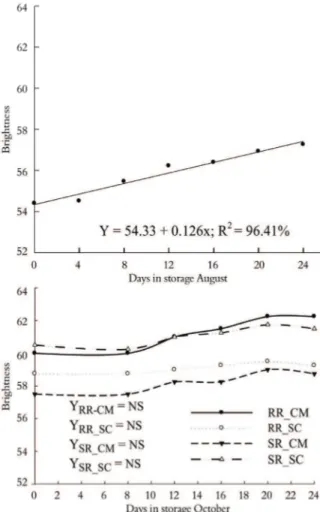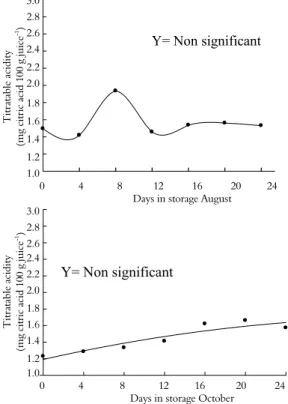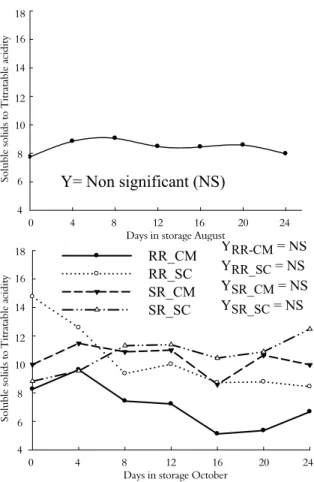http://www.uem.br/acta ISSN printed: 1679-9275
ISSN on-line: 1807-8621
Doi: 10.4025/actasciagron.v37i3.16970
The influence of rootstock and time of harvest on the fruit quality
during storage of in two grapefruit cultivars
Francisca Ligia de Castro Machado1*, Janaína de Paula da Costa2, Adunias dos Santos Teixeira3 and José Maria Correia da Costa4
1
Instituto Federal de Educação, Ciência e Tecnologia, Campus Tianguá, Rod. CE-075, s/n, 62320-000, Aeroporto, Tianguá, Ceará, Brazil. 2
Departamento de Engenharia de Pesca, Universidade Federal do Ceará, Fortaleza, Ceará, Brazil. 3Departamento de Engenharia Agrícola, Universidade Federal do Ceará, Fortaleza, Ceará, Brazil. 4Departamento de Tecnologia de Alimentos, Universidade Federal do Ceará, Fortaleza, Ceará, Brazil. *Author for correspondence. E-mail: ligia.machado@ifce.edu.br
ABSTRACT. The effects of the ‘Cleopatra’ mandarin and ‘Swingle’ citrumelo rootstocks and time of harvest on the quality of cold-stored (13°C and 90% R.H.) ‘Ruby Red’ and ‘Star Ruby’ grapefruit grown under the tropical conditions prevalent in Ceará state, Brazil, were evaluated. Fruit quality was assessed by mass loss and peel color, the percentage of juice, soluble solids, titratable acidity, pH, maturity index, and ascorbic acid content. The results suggested that ‘Ruby Red’ and ‘Star Ruby’ grapefruit presented similar amounts of soluble solids, pH, titratable acidity and ascorbic acid levels at harvest, and the trends over the course of storage followed similar patterns for both cultivars, regardless of rootstock. The influence of scion-rootstock combination on the studied variables was dependent on the time of harvest. The peel color of ‘Ruby Red’ grafted on ‘Swingle’ citrumelo is more vivid and redder when harvested in October than when harvested in August. ‘Ruby Red’ and ‘Star Ruby’ grapefruit harvested in October are sweeter, less acidic, juicier, and richer in ascorbic acid than those harvested in August. ‘Cleopatra’ mandarin rootstock might favor ascorbic acid levels at harvest, but the fruit may lose more weight during storage.
Keywords:Citrus paradisi Macf., postharvest, semi-arid conditions.
Influencia do porta-enxerto e época de colheita na qualidade do fruto durante o
armazenamento de duas cultivares de pomelos
RESUMO. Experimentos foram conduzidos objetivando verificar a influência dos porta-enxertos tangerina ‘Cleopatra’ e citrumeleiro ‘Swingle’, e época de colheita na qualidade dos pomelos ‘Ruby Red’ e ‘Star Ruby’ cultivados sob as condições semiáridas do Estado do Ceará e armazenados sob refrigeração (13°C e 90% U.R.). A qualidade dos frutos foi avaliada através das medições de perda de massa, coloração da casca, percentagem do suco, sólidos solúveis, acidez titulável, pH, índice de maturação e teores de ácido ascórbico. Os resultados sugerem que os pomelos ‘Ruby Red’ e ‘Star Ruby’ apresentam teores similares de sólidos solúveis, pH, acidez titulável e ácido ascórbico á colheita, enquanto as variações durante o armazenamento seguiram tendências semelhantes para ambos os cultivares, independente do porta-enxerto. Influências das combinações copa e porta-enxerto, à colheita, sobre as variáveis estudadas são dependentes da época de colheita. Frutos de ‘Ruby Red’ sobre citrumeleiro ‘Swingle’ colhidos em outubro são mais vermelhos e vívidos. ‘Ruby Red’ e ‘Star Ruby’ colhidos em outubro são mais doces, menos ácidos, suculentos e mais ricos em ácido ascórbico do que os colhidos em agosto. O porta-enxerto tangerina ‘Cleopatra’ pode favorecer o teor de ácido ascórbico à colheita, mas os frutos podem perder mais peso durante o armazenamento.
Palavras-chave: Citrus paradisi Macf., pós-colheita, condições semi-áridas.
Introduction
Research has firmly established the association between fruit consumption and good health, such that purchasing fruit now involves considerations that go beyond visual quality. The regular consumption of citrus fruit has a beneficial effect on human health. The healthy properties of citrus are credited to its wide array of bioactive compounds, such as vitamin C and flavonoids (WU et al., 2007).
The bioactive compounds in citrus fruit vary according to the variety, environmental conditions, and stage of maturity (GIRENNAVAR et al., 2008). For example, vitamin C content, including ascorbic acid, is influenced by genotype differences, preharvest climate conditions, maturity, and postharvest handling (LEE; KADER, 2000). Among the many types of citrus, the grapefruit [Citrus
attention because of its well-known nutritional properties; for example, grapefruit juice has recently been found to protect against high blood pressure and elevated cholesterol (WU et al., 2007).
The stage of fruit maturity and time of harvest are important factors in citrus storability and directly affect fruit quality. Grapefruits, which do not continue to ripen after harvest, should be harvested ripe. Pailly et al. (2004) studied harvest time and storage conditions of ‘Star Ruby’ grapefruit for short distance summer consumption and concluded that the period during which fruit are picked may be a key factor because early or delayed harvest can lengthen or shorten storage life. Chen et al. (2010) studied chemical differences in grapefruit with respect to year, harvest time, and conventional versus organic farming and observed that ‘Rio Red’ grapefruit from early, mid, and late harvests had distinctive chemical compositions.
Another pre-harvest factor that affects fruit quality and postharvest behavior is rootstock. Machado et al. (2011) examined the effect of citrus rootstocks on fruit quality of grapefruit cv. ‘Ruby Red’ grafted on ‘Swingle’ citrumelo (Citrus paradise × Poncirus trifoliata) or ‘Rangpur’ lime (Citrus limonia) rootstock and observed that fruit quality at harvest and during storage was markedly influenced by rootstock. Cano and Bermejo (2011) observed that both citrus rootstock and scion cultivar influenced the bioactive constituents in the rinds of cultivars of ‘Clementine’ mandarin (‘Fino’, ‘Loretina’, and ‘Marisol’), ‘Satsuma’ mandarin (‘Owari’), ‘Navel’ orange (‘Navelate’ and ‘Navelina’) and common orange (‘Valencia Late’) grafted on different rootstocks (‘Cleopatra’ mandarin and ‘Troyer’ citrange).
The goal of this work was to study the influence of rootstock (‘Swingle’ citrumelo and ‘Cleopatra’ mandarin) and time of harvest (August and October) on the quality, at harvest and during storage, of ‘Ruby Red’ and ‘Star Ruby’ grapefruit grown under the tropical conditions prevalent in Ceará State, Brazil.
Material and methods
‘Ruby Red’ and ‘Star Ruby’ grapefruit scions grafted on ‘Swingle’ citrumelo or ‘Cleopatra’ mandarin rootstocks were harvested at two periods (August 15th 2010 and October 15th 2010) from plantings located at Limoeiro do Norte (5°13’S latitude and 37°54’W longitude), Ceará, Brazil. The climate of that region is classified as BS’w’h, according to the Koppen classification. The annual average temperature is 28.5°C, and the average
precipitation is 772 mm year-1, irregularly distributed during the months of January-June. The average relative humidity is 62%.
To minimize differences in chemical composition among cultivars and rootstocks, fruits were harvested from plants sharing the same environmental, cultural and soil conditions during growth. At each harvest date, two sets of healthy fruit at the same maturity stage (fruit exhibiting a yellow color on more than 2/3 of its surface) were taken at random from the field.
Fruit storage and analysis were conducted at Universidade Federal do Ceará, Fortaleza, Ceará State Brazil. Upon arrival to the laboratory, the fruits were sorted for shape, size, freedom from defects and sunburn. The fruits were then rinsed with water at room temperature, air-dried, and stored under refrigerated conditions (12±1°C, 90±2% R.H.). Assessment for non-destructive and destructive analyses was performed immediately prior to storage and every four days for twenty-four days of storage. The non-destructive measurements were cumulative mass loss and surface color. The destructive measurements included peel resistance to puncturing, thickness of the peel, pulp color, soluble solids, titratable acidity, pH, maturity index, ascorbic acid, and total soluble sugars.
Cumulative weight loss was determined by weighing each previously numbered fruit during storage and then calculating its mass loss relative to its mass at harvest. Peel color was determined using a Minolta Chroma Meter (Minolta Corporation Instrument Systems). Values were scored from the opposite sides of the fruit. The results were expressed as luminosity, chroma and hue angle. Peel resistance to puncturing was assessed with a force gauge model DD-200 fitted with a 5 mm cylindrical probe in the probe carrier. The grapefruits were placed upon a flat plate with the stem calyx axis parallel to the surface of the plate. Puncture resistance, expressed as N, was recorded as the minimum force required to puncture the fruit surface.
The experiment was designed as a randomized complete block with a split-plot arrangement. The classes in the ANOVA were scion-rootstock combination (main plot) and storage durations (sub-plot), with four replicates. Linear regressions were used to describe trends during storage (R2 ≥ 70%) according to the procedure available in SAS. Mean separation was performed with Tukey test (p ≤ 0.05). Comparisons between rootstocks at harvest were performed by the Student's t-test. Differences at p ≤ 0.05 were considered significant.
Results and discussion
The weight of ‘Ruby Red’ fruit at harvest varied with the rootstock (p ≤ 0.05), but this variation was dependent on the time of harvest; a significant difference was observed only for fruit harvested in August (Table 1). The weight of ‘Star Ruby’ grapefruit at harvest did not differ with rootstock at either harvest time (p ≤ 0.05) (Table 2). In general, fruit harvested in October were heavier than those harvested in August.
Table 1. Differences in the quality parameters of freshly harvested ‘Ruby Red’ grapefruit grafted on ‘Cleopatra’ mandarin (CM) or ‘Swingle’ citrumelo (SC) rootstocks, harvested in August and October (Limoeiro do Norte, Ceará State, Brazil, 2010).
Quality parameters
Time of harvest
August October CM SC p-value CM SC p-value Weight 290.00 383.33 0.035** 438.67 448.0 0.875 Brightness 55.92 55.92 1.000 60.18 60.58 0.689 Chromaticity 26.40 26.50 1.000 29.71 35.08 0.001* Hue angle 72.10 72.00 1.000 70.34 54.95 0.006* Titratable acidity 1.36 1.65 0.052 1.50 0.93 0.177 Soluble solids 13.77 10.88 0.008* 11.50 13.63 0.109 SS:AT 10.08 6.58 0.001* 8.27 14.75 0.024** pH 3.13 2.90 0.015** 3.10 3.51 0.027** Ascorbic acid 51.74 54.65 0.194 61.19 66.48 0.642 Juice percentage 31.99 28.94 0.005* 32.52 38.74 0.097
* = Significant at 1% probability by Student´s Test; ** = Significant at 5% probability by Student´s Test.
Table 2. Differences in the quality parameters of freshly harvested ‘Star Ruby’ grapefruit grafted on ‘Cleopatra’ mandarin (CM) or ‘Swingle’ citrumelo (SC) rootstocks, harvested in August and October (Limoeiro do Norte, Ceará State, Brazil, 2010).
Quality parameters
Time of harvest
August October CM SC p-value CM SC p-value Weight 315.67 329.33 0.666 464.00 503.9 0.079
Brightness 54.63 53.68 0.507 58.84 6065 0.319 Chromaticity 27.37 29.52 0.132 30.29 29.83 0.540 Hue angle 70.90 60.62 0.276 65.89 67.03 0.665 Titratable acidity 1.69 1.23 0.004* 1.26 1.26 0.983 Soluble solids 11.37 9.67 0.073 12.47 12.13 0.581
SS:TA 6.76 7.54 0.295 9.99 8.82 0.132 pH 2.92 2.97 0.028** 3.27 3.16 0.227
Ascorbic acid 53.55 56.27 0.3019 67.11 58.28 0.084 Juice percentage 28.79 31.97 0.5841 32.94 31.67 0.7333
* = Significant at 1% probability by Student´s Test; ** = Significant at 5% probability by Student ´s Test.
During storage, cumulative weight loss increased with time, following a first-order polynomial equation for both cultivars harvested at either time (Figure 1).
For fruit harvested in August, rootstock played a role in cumulative weight loss. Grapefruits from both cultivars grafted on ‘Cleopatra’ mandarin lost a higher percentage of their weights during storage than did those grafted on ‘Swingle’ citrumelo rootstock (p ≤ 0.05) (Figure 1). The cumulative weight loss of fruit harvested in October did not differ significantly (p ≤ 0.05) between cultivars on both rootstocks, but it was affected over the course of storage. These results suggest that the effect of the scion-rootstock interaction on weight loss depends on the time of harvest.
In general, weight loss did not surpass 2.5% of the initial weight. This relatively low loss of weight may be due to the appropriate conditions during storage (12±1°C, 90±2% R.H.). The positive effects of low temperature and high relative humidity during storage on reducing weight loss in grapefruit have also been reported by Alferez et al. (2010).
Weigh
t loss (
%
)
2.5
2.0
1.5
1.0
0.5
0.0
RR_CM RR_SC SR_CM SR_SC
YRR-CM = NS
YRR_SC = NS
YSR_CM = NS
YSR_SC = NS
0 4 8 12 16 20 24 Days in storage August
Weigh
t loss (
%
)
2.5
2.0
1.5
1.0
0.5
0.0
Y = Non significant (NS)
0 4 8 12 16 20 24 Days in storage October
The influence of rootstock on the hue angle of the peel color of ‘Ruby Red’ fruit at harvest was dependent on the time of harvest, and a significant difference was observed only for ‘Ruby Red’ fruit harvested in October (Table 1). Fruit from ‘Ruby Red’ grafted on ‘Cleopatra’ mandarin had a yellow color, while fruit from ‘Ruby Red’ grafted on ‘Swingle’ citrumelo had a pink peel color (Figure 2). The peel color of ‘Star Ruby’ grapefruit at harvest did not differ with rootstock at either harvest date (p ≤ 0.05) (Table 2).
During storage, the average hue angle values of fruit from both cultivars at both harvest times presented similar trends, with values decreasing linearly with time (Figure 2). The hue angle of the peel of fruit harvested in August did not differ significantly (p ≤ 0.05) between cultivars on both rootstocks (Table 1 and Table 2) and decreased slightly with time. However, there were significant differences in hue angle for ‘Ruby Red’ fruit harvested in October (Table 1). Hue angle differences observed at harvest for fruit harvested in October were maintained during storage (Figure 2).
Hu
e an
gle
74
72
70
68
66
64
62
60
58
56
54
52
0 4 8 12 16 20 24 Days in storage August
Hu
e an
gle
74
72
70
68
66
64
62
60
58
56
54
52
RR - CM RR - SC SR - CM SR - SC
0 4 8 12 16 20 24 Days in storage October
Figure 2. The hue angles of ‘Ruby Red’ grapefruit grafted on ‘Cleopatra’ mandarin (RR-CM) and ‘Swingle’ citrumelo (RR-SC) rootstock and ‘Star Ruby’ grapefruit grafted on ‘Cleopatra’ mandarin (SR-CM) and ‘Swingle’ citrumelo (SR-SC) harvested in August and October and cold stored (Limoeiro do Norte, Ceará State, Brazil, 2010).
Polynomial equations:
August: Y = 69.55 - 0.26x; R2 = 77.11%
October: Y RR-CM = 73.18 - 0.34x; R2 = 92.61%; Y RR-SC = 55.35 - 0.47x, R2 = 92.64%; Y SR-CM = 64.41 - 0.133x; R2 = 97.91%; Y SR-SC = 66.71 - 0.17x; R2 = 98.89%;
as observed for hue angle, the influence of the rootstock on the peel chromaticity of ‘Ruby Red’ fruit was dependent on time of harvest; a significant difference (p ≤ 0.05) was observed only in fruit harvested in October (Table 1). The peel chromaticity of the ‘Star Ruby’ grapefruit at harvest did not differ between rootstocks at either harvest time (p ≤ 0.05) (Table 2). During storage, the chromaticity in both cultivars at both harvest times exhibited similar trends, with values increasing linearly during storage (Figure 3). Peel chromaticity in August did not differ significantly (p ≤ 0.05) between cultivars on both rootstocks, increasing with storage time. Fruit from both cultivars grafted on either rootstock and harvested in October showed significantly higher (p ≤ 0.05) average chromaticity values at harvest, consequently exhibiting more vivid peel color (Figure 3).
C
h
ro
m
ati
ci
ty
36
35
34
33
32
31
30
29
28
27
26
Chr
o
m
atic
ity
0 2 4 6 8 10 12 14 16 18 20 22 24 Days in storage August
C
h
ro
m
ati
ci
ty
36
35
34
33
32
31
30
29
28
27
26
RR - CM RR - CS SR - CM SR - CS
0 2 4 6 8 10 12 14 16 18 20 22 24 Days in storage October
Polynomial equations:
August: Y = 26.9 + 0.21x; R2 = 96.51%
October: Y RR-CM = 28.9 + 0.17x; R2 = 94.97%; Y RR-SC = 33.35 + 0.07x, R2 = 81.25%; Y SR-CM = 29.95 + 0.11x; R2 = 91.68%; Y SR-SC = 29.8 + 0.11x; R2 = 92.68%;
peel brightness at harvest did not vary with rootstock or time of harvest for either cultivar (Tables 1 and 2). The pattern of change in peel brightness during storage (Figure 4) was similar to that observed for chromaticity (Figure 3) and the reverse of that of hue angle (Figure 2), indicating that the peel color became lighter as brightness values increased during storage for both harvest times.
Fruit harvested in August showed significantly lower (p ≤ 0.05) average brightness values than those observed for fruit harvested in October (Figure 4). Thus, fruits harvested in August had a darker and grayer peel in comparison with those harvested in October. Considering that peel color is a major factor for consumer decisions, and assuming that a glowing, reddish color is more appealing to the human eye, ‘Ruby Red’ grafted on ‘Swingle’ citrumelo rootstock harvested in October stands out for its shining, vivid, pinkish colored fruit. These results corroborate our previous study (MACHADO et al., 2011), in which fruit from ‘Ruby Red’ or ‘Star Ruby’ grapefruit trees grafted on ‘Swingle’ citrumelo and harvested in October exhibited a bright, vivid, pinkish peel color.
Significant differences in peel color at harvest among the four scion-rootstock combinations observed in the October harvest may be the result of the interaction of the genotypes with climate factors during development and at time of harvest because all fruit shared the same environment, cultivation practices, and soil conditions. Additionally, the interactions between the genotypes and physiological factors, such as fruit load, may account for differences in peel color.
Rootstock and time of harvest affected the soluble solids content of ‘Ruby Red’ grapefruit, and Ruby Red’ grafted on ‘Cleopatra’ mandarin harvested in August yielded the fruit with the highest soluble solids content (Table 1).
Figure 4. Brightness of ‘Ruby Red’ grapefruit grafted on ‘Cleopatra’ mandarin CM) and ‘Swingle’ citrumelo (RR-SC) rootstock and ‘Star Ruby’ grapefruit grafted on ‘Cleopatra’ mandarin CM) and ‘Swingle’ citrumelo (SR-SC) harvested in August and October and cold stored (Limoeiro do Norte, Ceará State, Brazil, 2010).
Both ‘Ruby Red’ and ‘Star Ruby’ grapefruit grafted on both ‘Swingle’ citrumelo and ‘Cleopatra’ mandarin showed similar trends in soluble solid content over the storage period. The rootstocks did not influence the soluble solids content, and no significant differences were observed along the storage period (Figure 5).
Solu
b
le sol
ids
(ºB
rix
)
14.0
13.5
13.0
12.5
12.0
11.5
11.0
Y= Non significant
0 4 8 12 16 20 24 Days in storage August
Solub
le sol
ids
(ºB
rix
)
14.0
13.5
13.0
12.5
12.0
11.5
11.0
Y= Non significant
0 4 8 12 16 20 24 Days in storage October
Figure 5. Soluble solids content (°Brix) in ‘Ruby Red’ grapefruit grafted on ‘Cleopatra’ mandarin (RR-CM) and ‘Swingle’ citrumelo (RR-SC) rootstock and ‘Star Ruby’ grapefruit grafted on ‘Cleopatra’ mandarin CM) and ‘Swingle’ citrumelo (SR-SC) harvested in August and October and cold stored. (Limoeiro do Norte, Ceará State, Brazil, 2010).
Titra
tab
le ac
id
ity
(mg c
itric
ac
id 1
00 g
juic
e
-1)
3.0 2.8 2.6 2.4
2.2 2.0
1.8
1.6
1.4
1.2
1.0
Y= Non significant
0 4 8 12 16 20 24 Days in storage August
Titra
tab
le ac
id
ity
(mg c
itric
ac
id 1
00 g
juic
e
-1)
3.0
2.8 2.6 2.4 2.2
2.0
1.8 1.6 1.4
1.2 1.0
Y= Non significant
0 4 8 12 16 20 24 Days in storage October
Figure 6. Titratable acidity (mg of citric acid 100 g juice-1
) of ‘Ruby Red’ grapefruit grafted on ‘Cleopatra’ mandarin (RR-CM) and ‘Swingle’ citrumelo (RR-SC) rootstock and ‘Star Ruby’ grapefruit grafted on ‘Cleopatra’ mandarin (SR-CM) and ‘Swingle’ citrumelo (SR-SC) harvested in August and October and cold stored. (Limoeiro do Norte, Ceará State, Brazil, 2010).
The fruit pH at harvest was affected by the scion-rootstock combination for both ‘Ruby Red’ and ‘Star Ruby’ cultivars (Tables 1 and 2). Fruit grown on ‘Ruby Red’ grapefruit grafted on ‘Cleopatra’ mandarin and harvested in August produced higher pH values at harvest and during storage than did fruit grown on ‘Ruby Red’ grapefruit grafted on ‘Swingle’ citrumelo. However, this pattern was not observed for fruit harvested in October (Figure 7).
pH
3.8
3.6
3.4
3.2
3.0
2.8
2.6
2.4
2.2
2.0
Y= Non significant
0 4 8 12 16 20 24 Days in storage August
pH
3.8
3.6
3.4
3.2
3.0
2.8
2.6
2.4
2.2
2.0
Y= Non significant
0 4 8 12 16 20 24 Days in storage October
Figure 7. The pH of ‘Ruby Red’ grapefruit grafted on ‘Cleopatra’ mandarin (RR/CM) or ‘Swingle’ citrumelo (RR/SC) rootstock and ‘Star Ruby’ grapefruit grafted on ‘Cleopatra’ mandarin (SR/CM) and ‘Swingle’ citrumelo (SR/SC) harvested in August and October and cold stored. (Limoeiro do Norte, Ceará State, Brazil, 2010).
It is important to highlight that both cultivars had acceptable maturity indices at both harvests (Tables 1 and 2) and over the course of storage (Figure 8), meeting or surpassing existing international standards. In practical terms, both cultivars grafted on either rootstock produced excellent fruit, validated by the high maturity indices, which were similar to or higher than those reported for cultivars such as ‘Rio Red,’ ’Flame’, and ‘Ray Ruby’ grown in Mexico (BECERRA-RODRÍGUEZ et al., 2008) and for ‘Star Ruby’ and ‘Rio Red’ grown in Pernambuco State, Brazil (LEDERMAN et al., 2005).
Solub
le sol
ids t
o
Titr
atable ac
idit
y
18
16
14
12
10
8
6
4
Y= Non significant (NS)
0 4 8 12 16 20 24 Days in storage August
Solub
le sol
ids t
o
Titr
atable ac
idit
y
18
16
14
12
10
8
6
4
RR_CM RR_SC SR_CM SR_SC
YRR-CM= NS YRR_SC = NS YSR_CM = NS YSR_SC = NS
0 4 8 12 16 20 24 Days in storage October
Figure 8. Maturity indices of ‘Ruby Red’ grapefruit grafted on ‘Cleopatra’ mandarin CM) and ‘Swingle’ citrumelo (RR-SC) rootstock and ‘Star Ruby’ grapefruit grafted on ‘Cleopatra’ mandarin (SR-CM) and ‘Swingle’ citrumelo (SR-SC) harvested in August and October and cold stored (Limoeiro do Norte, Ceará State, Brazil, 2010).
Although October-harvested fruit had higher ascorbic acid levels at harvest, no significant differences between rootstocks were observed for either cultivar at either time of harvest (Tables 1 and 2).
The influence of genotype on ascorbic acid content during storage was observed only in fruit harvested in October (p ≤ 0.05). It is worth mentioning that fruit grown on ‘Cleopatra’
mandarin rootstock exhibited a greater increase in ascorbic acid during storage than that grown on Swingle citrumelo rootstock (Figure 9). Differences in ascorbic acid content have been shown to be the result of preharvest climatic conditions, genotype, and temperature.
Ascorbic acid content increased during storage for fruit harvested at either time. The average values at each time point during storage, as shown in Figure 9, surpassed the ascorbic acid values reported by Machado et al. (2011) for fruit harvested from ‘Ruby Red’ and ‘Star Ruby’ grafted on ‘Swingle’ citrumelo. That study also reported an increase in ascorbic acid during storage.
Asc
o
rbic
ac
id
(m
g 1
0
0
g jfw
-1)
105
100
95
90 85
80
75
70
65
60
55
50
45
40
0 4 8 12 16 20 24 Days in storage August
Asc
o
rbic
ac
id
(m
g 1
0
0
g jfw
-1)
105
100 95
90 85
80
75
70 65 60
55 50
45 40
RR - CM RR - SC SR - CM SR - SC
0 4 8 12 16 20 24 Days in storage October
Figure 9. The ascorbic acid contents of ‘Ruby Red’ grapefruit grafted on ‘Cleopatra’ mandarin (RR-CM) and ‘Swingle’ citrumelo (RR-SC) rootstock and ‘Star Ruby’ grapefruit grafted on ‘Cleopatra’ mandarin CM) and ‘Swingle’ citrumelo (SR-SC) harvested in August and October and cold stored (Limoeiro do Norte, Ceará State, Brazil, 2010).
Polynomial equation:
October: Y RR-CM = 63.50 + 1.65x; R2 = 95.69%; Y RR-SC = 67.15 + 4.82x – 0.36x2 + 0.009 x3, R2 = 75.71%; Y SR-CM = 65.33 + 1.16x; R2 = 83.33%; Y SR-SC = 59.85 + 2.15x – 0.067x2; R2 = 82.89%;
‘Ruby Red’ grapefruit grafted on ‘Cleopatra’ mandarin rootstock produced significantly higher juice percentages in August (Table 1). Overall, the time of harvest influenced juice percentage, and fruits harvested in October were juicier than those harvested in August (Tables 1 and 2).
No decline in percent juice over the course of storage was observed from harvest to the end of storage for both harvests (p ≤ 0.05). In general, the juice percentages found in this study were slightly lower than those reported for ‘Ray Ruby’ and ‘March Red’ grapefruits grown under dry tropical conditions in Colima, Mexico (BECERRA-RODRÍGUEZ et al., 2008).
Conclusion
October-harvested ‘Ruby Red’ grapefruit grafted on ‘Swingle’ citrumelo are redder with more vivid peel color.
The sweetest and least acid grapefruit is produced by the combination of ‘Ruby Red’ grapefruit grafted on ‘Cleopatra’ mandarin rootstock, harvested in August or ‘Ruby Red’ grapefruit grafted on ‘Swingle’ citrumelo rootstock, harvested in October.
October-harvested fruit had higher levels of ascorbic acid at harvest, and ‘Cleopatra’ mandarin rootstock produced the greatest increase in ascorbic acid over the course of storage.
October-harvested fruit are juicer than August-harvested fruit. Juice content does not decline during storage under the stated storage conditions.
Acknowledgements
The authors thank the Banco do Nordeste do Brasil (BNB) for financial support and the Fundação Cearense de Apoio a Pesquisa e Desenvolvimento (FUNCAP) for granting a scholarship to the first author. We also thank Anne Mary Gillen, PhD, for greatly contributing to the preparation of this manuscript and Professor Patrícia Verônica Pinheiro Sales for assistance with the statistical analyses.
References
ALFEREZ, F.; ALQUEZAR, B.; BURNS, J. K.; ZACARIAS, L. Variation in water, osmotic and turgor potential in peel of ‘Marsh’ grapefruit during development
of postharvest peel pitting. Postharvest Biology and Technology, v. 56, n. 1, p. 44-49, 2010.
BECERRA-RODRÍGUEZ, S.; MEDINA-URRUTIA, V. M.; ROBLES-GONZÁLEZ, M. M.; WILLIAMS, T. Performance of various grapefruit (Citrus paradisi Macf.) and pummelo (C. maxima Merr.) cultivars under the dry tropic conditions of Mexico. Euphytica, v. 164, n. 1, p. 27-36, 2008.
CANO, A.; BERMEJO, A. Influence of rootstock and cultivar on bioactive compounds in citrus peels. Journal of Science and Food Agriculture, v. 91, n. 9, p. 1702-1711, 2011.
CHEN, P.; HARNLY, J. M.; LESTER, G. L. Flow Injection Mass Spectral Fingerprints Demonstrate Chemical Differences in Rio Red Grapefruit with Respect to Year, Harvest Time, and Conventional versus Organic Farming. Journal of Agricultural and Food Chemistry, v. 58, n. 8, p. 4545-4553, 2010.
GIRENNAVAR, B.; JAYAPRAKASHA, G. K.; JIFON, J. L.; PATIL, B. S. Variation of bioactive furocoumarins and Xavonoids in different varieties of grapefruits and pummelo. European Food Research and Technology, v. 226, n. 6, p. 1269-1275, 2008.
HERNÁDEZ, Y.; LOBO, M. G.; GONZÁLEZ, M. Determination of vitamin C in tropical fruits: A comparative evaluation of methods. Food Chemistry, v. 96, n. 4, p. 654-664, 2006.
LEDERMAN, I. E.; BEZERRA, J. E. F.; ALVES, M. A.; COELHO, Y. S.; SOBRINHO, A. P. C. Comportamento de seis variedades de pomelo (Citrus paradisi Macfad.) cultivadas sob irrigação na regiao semi-arida de Pernambuco. Revista Brasileira de Fruticultura, v. 27, n. 1, p. 245-247, 2005.
LEE, S. K.; KADER, A. A. Preharvest and postharvest factors influencing vitamin C content of horticultural crops. Postharvest Biology and Technology, v. 20, n. 3, p. 207-220, 2000.
MACHADO, F. L. C.; OLIVEIRA, V. S.; COSTA, J. M. C. Postharvest quality of grapefruit (Citrus paradisi Macf.) produced from initial plantings in Ceará state, Brazil. Revista Ciência Agronômica, v. 42, n. 4, p. 883-888, 2011.
PAILLY, O.; TISON, G.; AMOUROUX, A. Harvest time and storage conditions of ‘Star Ruby’ grapefruit (Citrus paradisi Macf.) for short distance summer consumption. Postharvest Biology and Technology, v. 34, n. 1, p. 65-73, 2004.
WU, T.; GUAN, Y.; YE, J. Determination of flavonoids and ascorbic acid in grapefruit peel and juice by capillary electrophoresis with electrochemical detection. Food Chemistry, v. 100, n. 4, p. 1573-1579, 2007.
Received on April 27, 2012. Accepted on October 13, 2012.
